Short-Term Probabilistic Wind Speed Predictions Integrating Multivariate Linear Regression and Generative Adversarial Network Methods
Abstract
1. Introduction
2. Theory Descriptions of Related Methods
2.1. CEEMDAN Method
2.2. GAN Model
2.2.1. Discriminative Model: CNN
2.2.2. Generative Model-BIGRU
2.3. Interval Prediction Theory
2.4. Performance Evaluation Indices
3. Case Studies
3.1. Data Collection
3.2. Short-Term Probabilistic WSP
3.2.1. Decomposition Results of the CEEMDAN Method
3.2.2. The Results of Single-Step and Multi-Step Interval Predictions
- (1)
- It is readily apparent that these four models yield accurate interval predictions, with a PICP value of one across these four datasets. For instance, considering dataset 4, the CEEMDAN-CNN model exhibits the highest PINAW, with a value of 0.432. This implies that this model provides the least accurate PI compared to the other three models, as clearly depicted in Figure 3. Furthermore, the predicting accuracy of the CEEMDAN-BIGRU surpasses that of the CEEMDAN-GRU, and the forecasting accuracies of these two models are both inferior to that from the suggested model, presenting PINAWs of 0.38, 0.189, and 0.204 in respective order.
- (2)
- In terms of the CWC, the suggested approach significantly outperforms the other analogous techniques, owing to its minimal CWC. This outcome is anticipated as the suggested model maintains a minimal PINAW and comparable or even superior PICP. Relative to the CEEMDAN-CNN, the CWC shows an enhancement of 68.06% in single-step interval forecasting for dataset 4. When compared with the other two models, the CWC values of the suggested model consistently remain the smallest. Similar conclusions can be drawn for multi-step interval forecasting. In conclusion, upon reviewing each performance indicator, the proposed approach outshines the rival standard approaches in individual as well as sequential interval projections. The reason is that the proposed model consists of two models (discriminative model—CNN; generative model—BIGRU), and combines the strengths of these two models. Additionally, compared with the GRU, the BIGRU is effective in capturing temporal correlation, whether originating from past or future data. Therefore, the proposed model performs better than the other benchmark models.
3.3. Verification of Distribution Estimation
4. Conclusions
- (1)
- A novel generative adversarial network (GAN) enhanced by CEEMDAN is suggested to achieve the PI for wind speed grounded in the multivariate linear regression theory. This suggested model is adept at accurately capturing the randomness in wind speed and quantifying and reducing the uncertainty of forecasting outcomes.
- (2)
- The operation of the suggested approach for both single-stage and multiple-stage projections is confirmed through the utilization of four datasets. When concerning interval predictions of dataset 4, the PINAW values of the recommended model are disclosed as 0.138 and 0.127 for diverse PINC quantities of 0.95 and 0.9 in single-step prediction in a respective manner.
- (3)
- The experimental outcomes suggest that the operation of the suggested model excels the over relative techniques because of its reduced PINAW with CWC values, all the while maintaining identical PICP values. Fundamentally, it creates PIs that encapsulate the unpredictability in the wind speed forecasting.
Author Contributions
Funding
Data Availability Statement
Conflicts of Interest
References
- Sadorsky, P. Wind energy for sustainable development: Driving factors and future outlook. J. Clean. Prod. 2021, 289, 125779. [Google Scholar] [CrossRef]
- Wang, Y.; Hu, Q.; Li, L.; Foley, A.M.; Srinivasan, D. Approaches to wind power curve modeling: A review and discussion. Renew. Sustain. Energy Rev. 2019, 116, 109422. [Google Scholar] [CrossRef]
- Zhao, X.Y.; Liu, J.F.; Yu, D.R.; Chang, J.T. One-day-ahead probabilistic wind speed forecast based on optimized numerical weather prediction data. Energy Convers. Manag. 2018, 164, 560–569. [Google Scholar] [CrossRef]
- Landberg, L. Short-term prediction of the power production from wind farms. J. Wind. Eng. Ind. Aerod. 1999, 80, 207–220. [Google Scholar] [CrossRef]
- Miguel, Á.P.F.; Carlos-Otero, C.; Felipe, C.F.; Gonzalo, M.M. Wind power forecasting for a real onshore wind farm on complex terrain using WRF high resolution simulations. Renew. Energy 2019, 135, 674–686. [Google Scholar]
- Zhao, J.; Guo, Y.; Xiao, X.; Wang, J.; Chi, D.; Guo, Z. Multi-step wind speed and power forecasts based on a WRF simulation and an optimized association method. Appl. Energy 2017, 197, 183–202. [Google Scholar] [CrossRef]
- Chen, K.; Yu, J. Short-term wind speed prediction using an unscented Kalman filter based state-space support vector regression approach. Appl. Energy 2014, 113, 690–705. [Google Scholar] [CrossRef]
- Guo, Z.; Zhao, J.; Zhang, W.; Wang, J. A corrected hybrid approach for wind speed prediction in Hexi Corridor of China. Energy 2011, 36, 1668–1679. [Google Scholar] [CrossRef]
- Cassola, F.; Burlando, M. Wind speed and wind energy forecast through Kalman filtering of Numerical Weather Prediction model output. Appl. Energy 2012, 99, 154–166. [Google Scholar] [CrossRef]
- Khosravi, A.; Koury, R.N.N.; Machado, L.; Pabon, J.J.G. Prediction of wind speed and wind direction using artificial neural network, support vector regression and adaptive neuro-fuzzy inference system. Sustain. Energy Technol. Assess. 2018, 25, 146–160. [Google Scholar] [CrossRef]
- Liu, H.; Tian, H.Q.; Pan, D.F.; Li, Y.F. Forecasting models for wind speed using wavelet, wavelet packet, time series and Artificial Neural Networks. Appl. Energy 2013, 107, 191–208. [Google Scholar] [CrossRef]
- Kong, X.; Liu, X.; Shi, R.; Lee, K.Y. Wind speed prediction using reduced support vector machines with feature selection. Neurocomputing 2015, 169, 449–456. [Google Scholar] [CrossRef]
- Saeed, A.; Li, C.S.; Gan, Z.H.; Xie, Y.Y.; Liu, F.J. A simple approach for short-term wind speed interval prediction based on independently recurrent neural networks and error probability distribution. Energy 2022, 238, 122012. [Google Scholar] [CrossRef]
- Zhang, Y.G.; Pan, G.F.; Zhao, Y.P.; Li, Q.; Wang, F. Short-term wind speed interval prediction based on artificial intelligence methods and error probability distribution. Energy Convers. Manag. 2020, 224, 113346. [Google Scholar] [CrossRef]
- Wang, J.Z.; Cheng, Z.S. Wind speed interval prediction model based on variational mode decomposition and multi-objective optimization. Appl. Soft Comput. 2021, 113, 107848. [Google Scholar] [CrossRef]
- Liu, H.; Mi, X.W.; Li, Y.F. An experimental investigation of three new hybrid wind speed forecasting models using multi-decomposing strategy and ELM algorithm. Renew. Energy 2018, 123, 694–705. [Google Scholar] [CrossRef]
- Liu, Z.Y.; Hara, R.; Kita, H. Hybrid forecasting system based on data area division and deep learning neural network for short-term wind speed forecasting. Energy Convers. Manag. 2021, 238, 114136. [Google Scholar] [CrossRef]
- Ruiz-Aguilar, J.J.; Turias, I.; González-Enrique, J.; Urda, D.; Elizondo, D. A permutation entropy-based EMD-ANN forecasting ensemble approach for wind speed prediction. Neural Comput. Appl. 2021, 33, 2369–2391. [Google Scholar] [CrossRef]
- Liu, H.; Yu, C.; Wu, H.; Duan, Z.; Yan, G. A new hybrid ensemble deep reinforcement learning model for wind speed short term forecasting. Energy 2020, 202, 117794. [Google Scholar] [CrossRef]
- Memarzadeh, G.; Keynia, F. A new short-term wind speed forecasting method based on fine-tuned LSTM neural network and optimal input sets. Energy Convers. Manag. 2020, 213, 112824. [Google Scholar] [CrossRef]
- Xiang, L.; Li, J.X.; Hu, A.J.; Zhang, Y. Deterministic and probabilistic multi-step forecasting for short-term wind speed based on secondary decomposition and a deep learning method. Energy Convers. Manag. 2020, 220, 113098. [Google Scholar] [CrossRef]
- Xiang, H.Y.; Zhang, M.J. Data mining-assisted short-term wind speed forecasting by wavelet packet decomposition and Elman neural network. J. Wind. Eng. Ind. Aerod. 2018, 175, 136–143. [Google Scholar]
- Zhang, L.F.; Wang, J.Z.; Niu, X.S.; Liu, Z.K. Ensemble wind speed forecasting with multi-objective Archimedes optimization algorithm and sub-model selection. Appl. Energy 2021, 301, 117449. [Google Scholar] [CrossRef]
- Ding, W.; Meng, F.Y. Point and interval forecasting for wind speed based on linear component extraction. Appl. Soft. Comput. 2020, 93, 106350. [Google Scholar] [CrossRef]
- Sun, W.; Tan, B.; Wang, Q.Q. Multi-step wind speed forecasting based on secondary decomposition algorithm and optimized back propagation neural network. Appl. Soft Comput. 2021, 113, 107894. [Google Scholar] [CrossRef]
- Zhang, G.W.; Liu, D. Causal convolutional gated recurrent unit network with multiple decomposition methods for short-term wind speed forecasting. Energy Convers. Manag. 2020, 226, 113500. [Google Scholar] [CrossRef]
- Hu, C.; Zhao, Y.; Jiang, H.; Jiang, M.; You, F.; Liu, Q. Prediction of ultra-short-term wind power based on CEEMDAN-LSTM-TCN. Energy Rep. 2022, 8, 483–492. [Google Scholar] [CrossRef]
- Wang, S.X.; Shi, J.R.; Yang, W.; Yin, Q.Y. High and low frequency wind power prediction based on Transformer and BiGRU-Attention. Energy 2024, 288, 129753. [Google Scholar] [CrossRef]
- Wang, S.; Zhang, N.; Wu, L.; Wang, Y. Wind speed forecasting based on the hybrid ensemble empirical mode decomposition and GA-BP neural network method. Renew. Energy 2016, 94, 629–636. [Google Scholar] [CrossRef]
- Zhang, C.; Wei, H.; Zhao, J.; Liu, T.; Zhu, T.; Zhang, K. Short-term wind speed forecasting using empirical mode decomposition and feature selection. Renew. Energy 2016, 96, 727–737. [Google Scholar] [CrossRef]
- Goodfellow, I.J.; Pouget-Abadie, J.; Mirza, M.; Xu, B.; Warde-Farley, D.; Ozair, S.; Courville, A.; Bengio, Y. Generative adversarial nets. Adv. Neural Inf. Process. Syst. 2014, 2, 2672–2680. [Google Scholar]
- Yuan, R.; Wang, B.; Mao, Z.X.; Watada, J. Multi-objective wind power scenario forecasting based on PG-GAN. Energy 2021, 226, 120379. [Google Scholar] [CrossRef]
- Zhang, Y.M.; Wang, H. Multi-head attention-based probabilistic CNN-BiLSTM for day-ahead wind speed forecasting. Energy 2023, 278, 127865. [Google Scholar] [CrossRef]
- Zhu, X.X.; Liu, R.Z.; Chen, Y.; Gao, X.X.; Wang, Y.; Xu, Z.X. Wind speed behaviors feather analysis and its utilization on wind speed prediction using 3D-CNN. Energy 2021, 236, 121523. [Google Scholar] [CrossRef]
- Yu, M.; Niu, D.X.; Gao, T.; Wang, K.K.; Sun, L.J.; Li, M.Y.; Xu, X.M. A novel framework for ultra-short-term interval wind power prediction based on RF-WOA-VMD and BiGRU optimized by the attention mechanism. Energy 2023, 269, 126738. [Google Scholar] [CrossRef]
- Fanta, H.; Shao, Z.W.; Ma, L.Z. SiTGRU: Single-tunnelled gated recurrent unit for abnormality detection. Inf. Sci. 2020, 524, 15–32. [Google Scholar] [CrossRef]
- Zhu, T.; Wang, W.B.; Yu, M. A novel hybrid scheme for remaining useful life prognostic based on secondary decomposition, BiGRU and error correction. Energy 2023, 276, 127565. [Google Scholar] [CrossRef]
- Meng, F.; Song, T.; Xu, D.Y.; Xie, P.F.; Li, Y. Forecasting tropical cyclones wave height using bidirectional gated recurrent unit. Ocean. Eng. 2021, 234, 108795. [Google Scholar] [CrossRef]
- Khosravi, A.; Nahavandi, S.; Creighton, D.; Atiya, A.F. Lower upper bound estimation method for construction of neural network-based prediction intervals. IEEE Trans. Neural Networks 2011, 22, 337–346. [Google Scholar] [CrossRef]
- Jager, D.; Andreas, A. NREL National Wind Technology Center (NWTC): M2 Tower; Boulder, Colorado (Data); NREL Report No. DA-5500-56489; National Renewable Energy Laboratory (NREL): Golden, CO, USA, 1996. [Google Scholar]
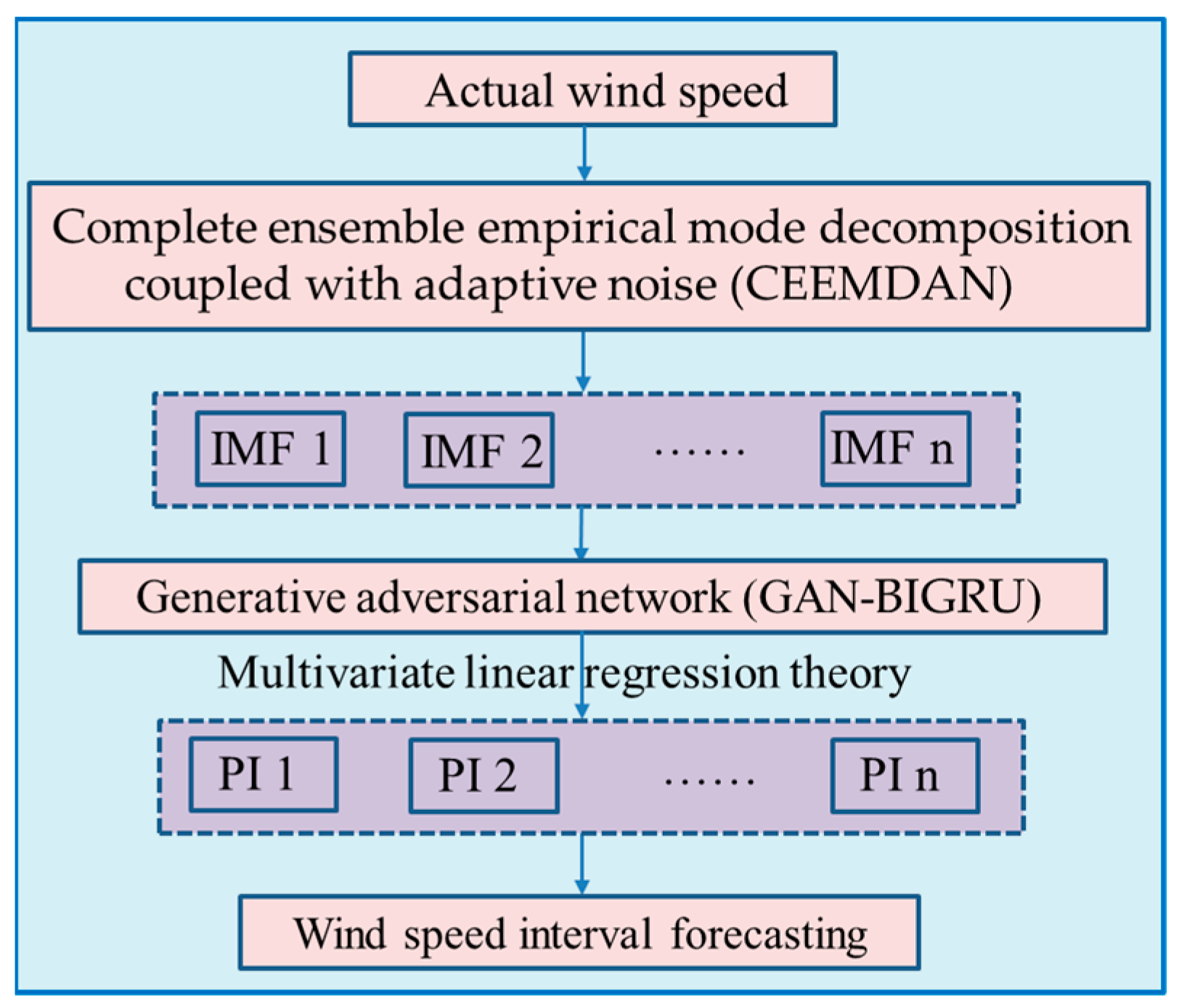
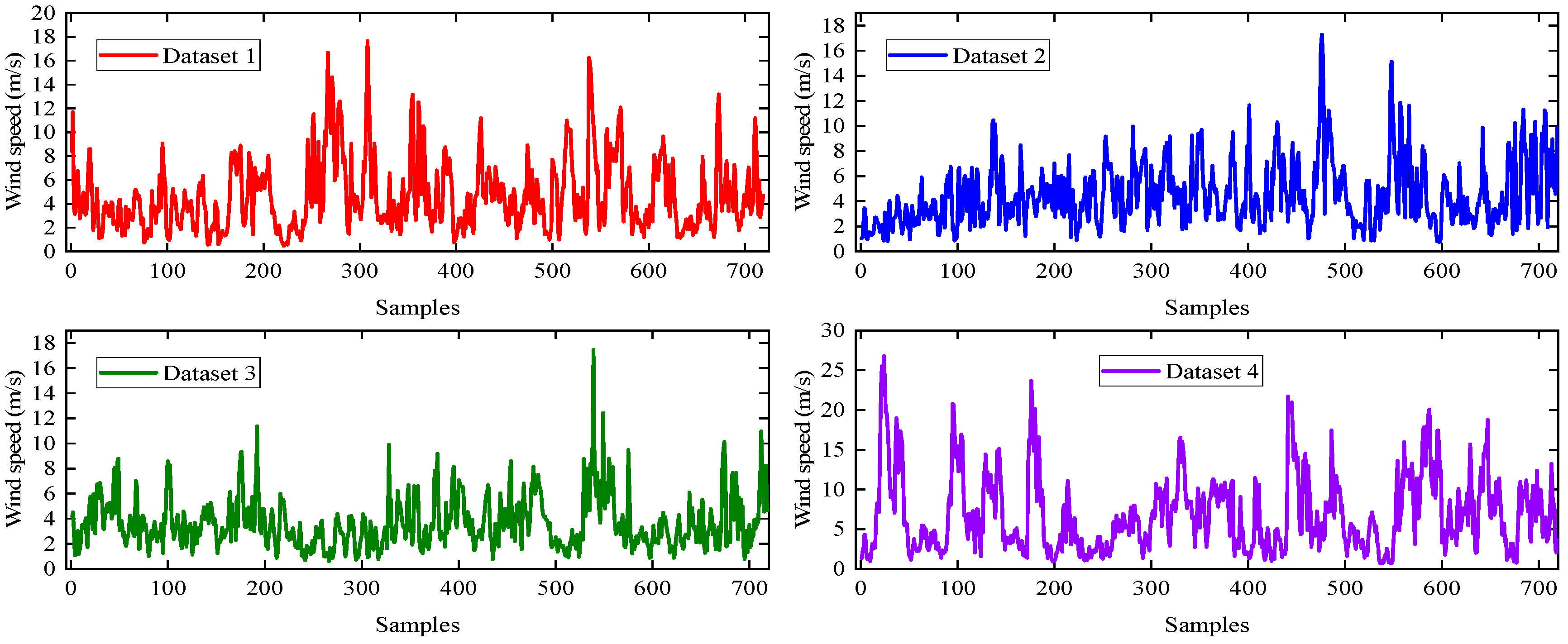
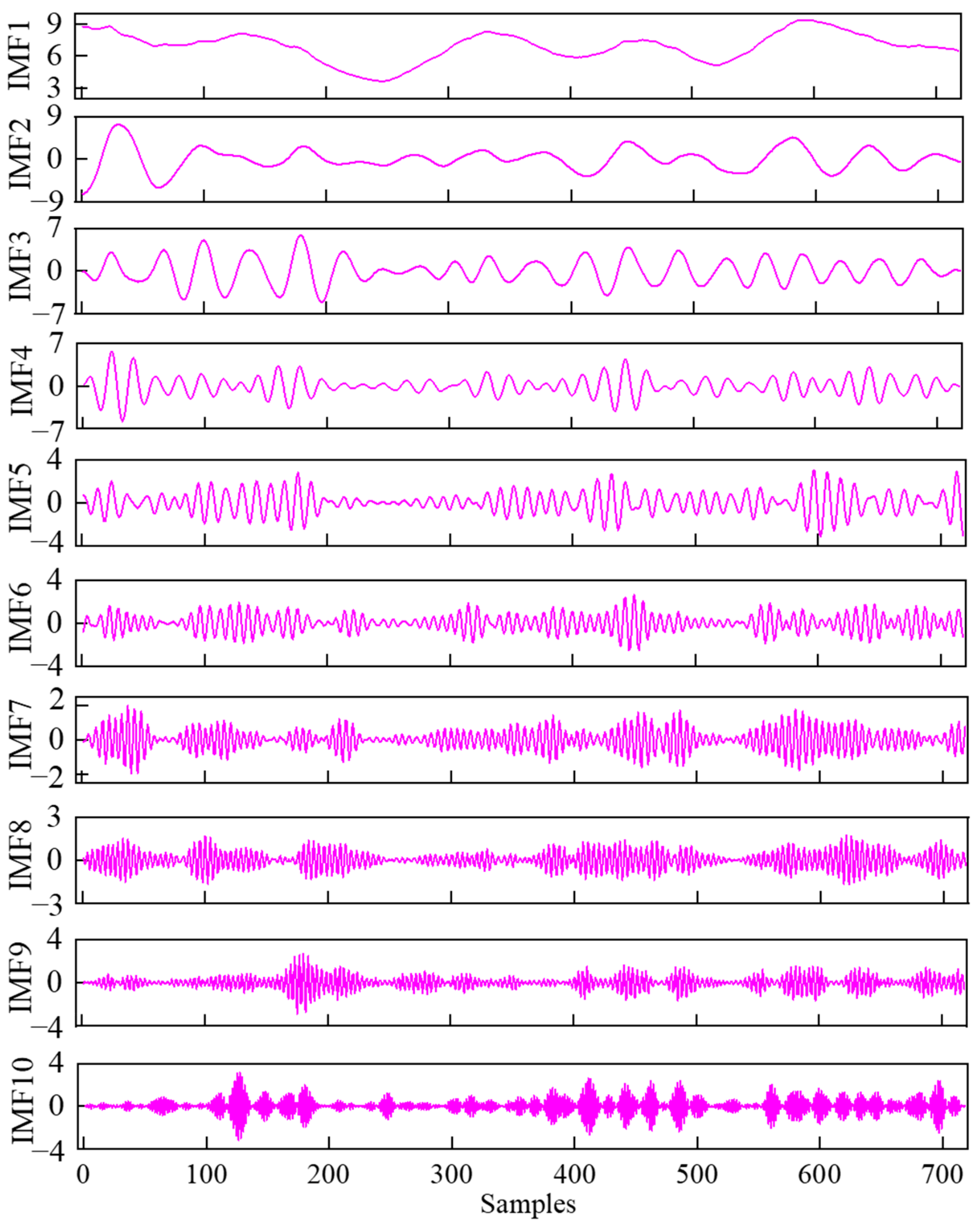
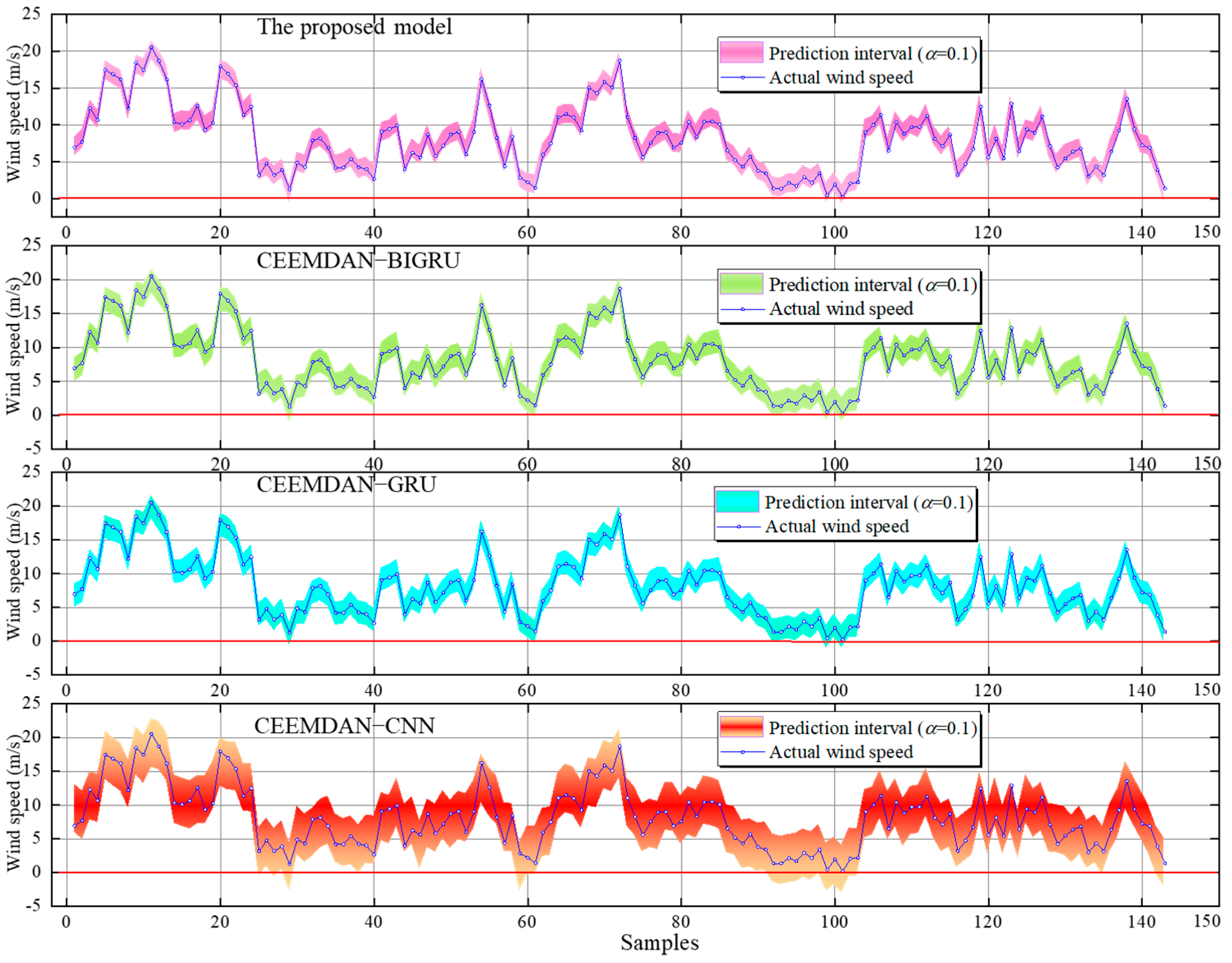
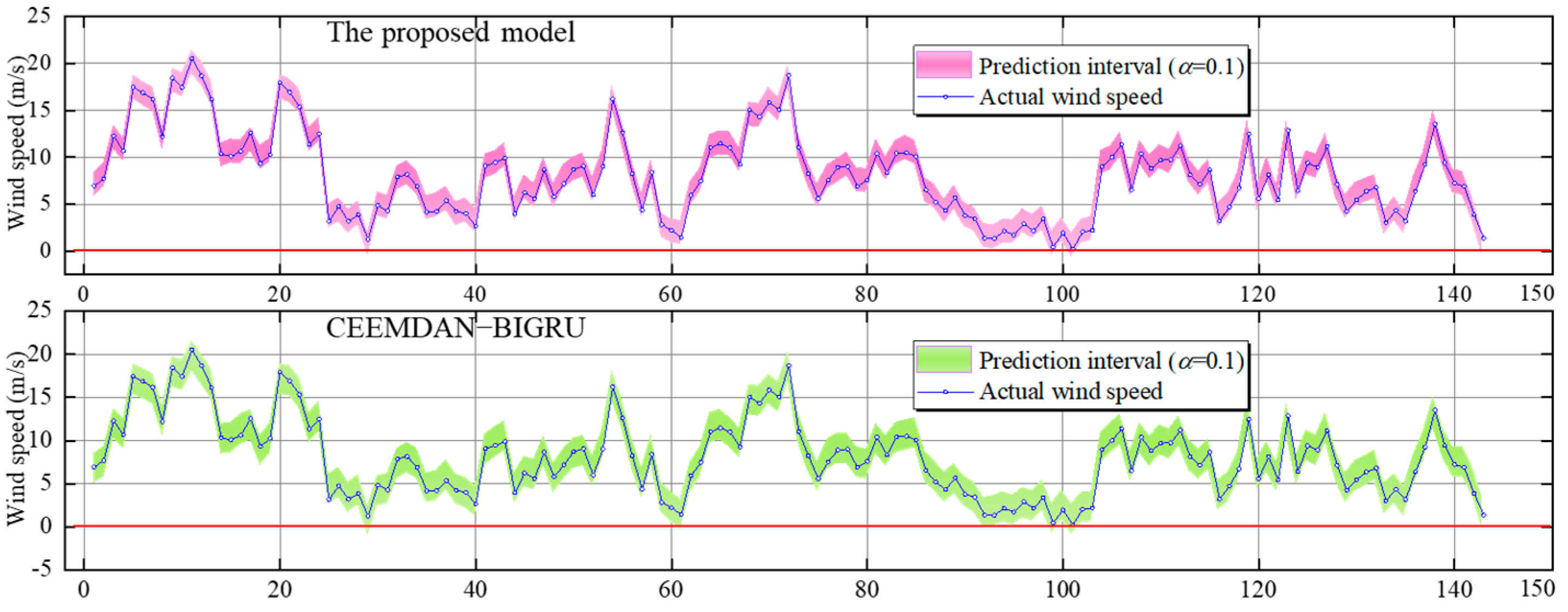
| CNN Configuration s from D Model | ||
|---|---|---|
| Conv1D | filter counts | 128 |
| kernel sizes | 2 | |
| activation function | LeakyRelu | |
| Conv1D | filter counts | 256 |
| kernel sizes | 2 | |
| activation function | LeakyRelu | |
| Conv1D | filter counts | 512 |
| kernel sizes | 2 | |
| activation function | LeakyRelu | |
| Dense | units | 256 |
| activation function | relu | |
| Model | Parameters | Quantity |
|---|---|---|
| GAN-BIGRU | Quantity of GRU layers | 3 |
| Count of neurons within GRU layers | 128, 256, 512 | |
| Size of the batch | 4 | |
| Optimization method | adam |
| Models | Datasets | Single-Step | Two-Step | ||||
|---|---|---|---|---|---|---|---|
| PICP | PINAW | CWC | PICP | PINAW | CWC | ||
| CEEMDAN-CNN | Dataset1 | 1 | 0.562 | 0.562 | 1 | 0.582 | 0.582 |
| Dataset2 | 1 | 0.543 | 0.543 | 1 | 0.630 | 0.630 | |
| Dataset3 | 1 | 0.554 | 0.554 | 1 | 0.576 | 0.576 | |
| Dataset4 | 1 | 0.432 | 0.432 | 1 | 0.450 | 0.450 | |
| CEEMDAN-GRU | Dataset1 | 1 | 0.261 | 0.261 | 1 | 0.335 | 0.335 |
| Dataset2 | 1 | 0.260 | 0.260 | 1 | 0.338 | 0.338 | |
| Dataset3 | 1 | 0.217 | 0.217 | 1 | 0.286 | 0.286 | |
| Dataset4 | 1 | 0.204 | 0.204 | 1 | 0.268 | 0.268 | |
| CEEMDAN-BIGRU | Dataset1 | 1 | 0.258 | 0.258 | 1 | 0.330 | 0.330 |
| Dataset2 | 1 | 0.257 | 0.257 | 1 | 0.320 | 0.320 | |
| Dataset3 | 1 | 0.201 | 0.201 | 1 | 0.285 | 0.285 | |
| Dataset4 | 1 | 0.189 | 0.189 | 1 | 0.261 | 0.261 | |
| The proposed model | Dataset1 | 1 | 0.186 | 0.186 | 1 | 0.251 | 0.251 |
| Dataset2 | 1 | 0.149 | 0.149 | 1 | 0.262 | 0.262 | |
| Dataset3 | 1 | 0.151 | 0.151 | 1 | 0.221 | 0.221 | |
| Dataset4 | 1 | 0.138 | 0.138 | 1 | 0.207 | 0.207 | |
| Model | Dataset | Five-step | Seven-step | ||||
| PICP | PINAW | CWC | PICP | PINAW | CWC | ||
| CEEMDAN-CNN | Dataset1 | 1 | 0.745 | 0.745 | 1 | 0.841 | 0.841 |
| Dataset2 | 1 | 0.758 | 0.758 | 1 | 0.864 | 0.864 | |
| Dataset3 | 1 | 0.719 | 0.719 | 1 | 0.797 | 0.797 | |
| Dataset4 | 1 | 0.576 | 0.576 | 1 | 0.683 | 0.683 | |
| CEEMDAN-GRU | Dataset1 | 1 | 0.557 | 0.557 | 1 | 0.685 | 0.685 |
| Dataset2 | 1 | 0.573 | 0.573 | 1 | 0.696 | 0.696 | |
| Dataset3 | 1 | 0.469 | 0.469 | 1 | 0.588 | 0.588 | |
| Dataset4 | 1 | 0.481 | 0.481 | 1 | 0.617 | 0.617 | |
| CEEMDAN-BIGRU | Dataset1 | 1 | 0.535 | 0.535 | 1 | 0.671 | 0.671 |
| Dataset2 | 1 | 0.549 | 0.549 | 1 | 0.695 | 0.695 | |
| Dataset3 | 1 | 0.461 | 0.461 | 1 | 0.571 | 0.571 | |
| Dataset4 | 1 | 0.469 | 0.469 | 1 | 0.576 | 0.576 | |
| The proposed model | Dataset1 | 1 | 0.447 | 0.447 | 1 | 0.564 | 0.564 |
| Dataset2 | 1 | 0.464 | 0.464 | 1 | 0.604 | 0.604 | |
| Dataset3 | 1 | 0.388 | 0.388 | 1 | 0.503 | 0.503 | |
| Dataset4 | 1 | 0.392 | 0.392 | 1 | 0.507 | 0.507 | |
| α = 0.1 | Datasets | PICP | PINAW | CWC |
|---|---|---|---|---|
| CEEMDAN-BIGRU | Dataset1 | 1 | 0.218 | 0.218 |
| Dataset2 | 1 | 0.220 | 0.220 | |
| Dataset3 | 1 | 0.191 | 0.191 | |
| Dataset4 | 1 | 0.169 | 0.169 | |
| The proposed model | Dataset1 | 1 | 0.122 | 0.122 |
| Dataset2 | 1 | 0.148 | 0.148 | |
| Dataset3 | 1 | 0.135 | 0.135 | |
| Dataset4 | 1 | 0.127 | 0.127 |
Disclaimer/Publisher’s Note: The statements, opinions and data contained in all publications are solely those of the individual author(s) and contributor(s) and not of MDPI and/or the editor(s). MDPI and/or the editor(s) disclaim responsibility for any injury to people or property resulting from any ideas, methods, instructions or products referred to in the content. |
© 2024 by the authors. Licensee MDPI, Basel, Switzerland. This article is an open access article distributed under the terms and conditions of the Creative Commons Attribution (CC BY) license (https://creativecommons.org/licenses/by/4.0/).
Share and Cite
Dong, Y.; Li, C.; Shi, H.; Zhou, P. Short-Term Probabilistic Wind Speed Predictions Integrating Multivariate Linear Regression and Generative Adversarial Network Methods. Atmosphere 2024, 15, 294. https://doi.org/10.3390/atmos15030294
Dong Y, Li C, Shi H, Zhou P. Short-Term Probabilistic Wind Speed Predictions Integrating Multivariate Linear Regression and Generative Adversarial Network Methods. Atmosphere. 2024; 15(3):294. https://doi.org/10.3390/atmos15030294
Chicago/Turabian StyleDong, Yingfei, Chunguang Li, Hongke Shi, and Pinhan Zhou. 2024. "Short-Term Probabilistic Wind Speed Predictions Integrating Multivariate Linear Regression and Generative Adversarial Network Methods" Atmosphere 15, no. 3: 294. https://doi.org/10.3390/atmos15030294
APA StyleDong, Y., Li, C., Shi, H., & Zhou, P. (2024). Short-Term Probabilistic Wind Speed Predictions Integrating Multivariate Linear Regression and Generative Adversarial Network Methods. Atmosphere, 15(3), 294. https://doi.org/10.3390/atmos15030294






